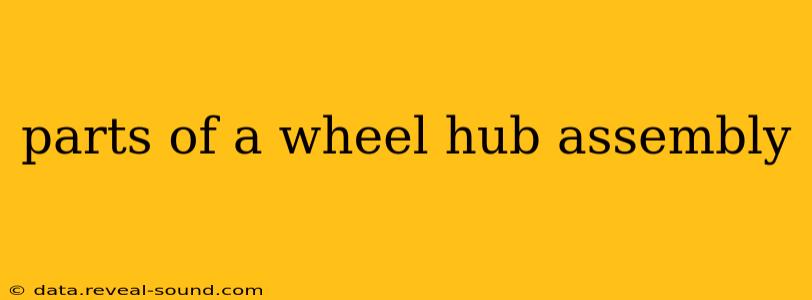The wheel hub assembly is a critical component of your vehicle, responsible for safely connecting the wheel to the vehicle's suspension. Understanding its parts is crucial for effective maintenance and repair. This guide will break down the key components of a wheel hub assembly, answering common questions along the way.
What are the main parts of a wheel hub assembly?
The wheel hub assembly is comprised of several interconnected parts working in concert to support the vehicle's weight and facilitate smooth rotation. These key components include:
-
Wheel Hub: This is the central part, a cylindrical component that acts as the mounting point for the wheel. It's precisely machined to ensure a secure and accurate fit for the wheel bearings and wheel studs.
-
Wheel Bearings: These are crucial for reducing friction and allowing the wheel to rotate smoothly. Wheel bearings typically consist of multiple precision-engineered components, often including inner and outer races, rollers or balls, and a cage to maintain their precise alignment. They are usually lubricated with grease for optimal performance.
-
Bearing Races: These are the inner and outer rings that hold the bearing elements (rollers or balls) in place. Their precise machining is vital for preventing bearing failure.
-
Wheel Studs: These threaded metal rods extend from the wheel hub and fasten the wheel to the assembly. They provide the necessary strength to secure the wheel under various driving conditions. The number of studs varies depending on the vehicle.
-
ABS Sensor Ring (or Tone Ring): This ring, made of either a toothed metal or a magnetic material, is usually integrated into the wheel hub assembly. It generates signals used by the Anti-lock Braking System (ABS) to monitor wheel speed. These signals are crucial for the effective functioning of the ABS.
-
Dust Cap/Seal: A protective covering that shields the wheel bearings from contaminants like dirt, dust, and water, extending their lifespan.
What is the difference between a wheel hub and a wheel bearing?
The wheel hub is the central mounting point for the wheel and the entire assembly. The wheel bearings are housed within the wheel hub and are responsible for the smooth rotation of the wheel. The bearings allow for rotation with minimal friction, whereas the hub provides the structural support and mounting point for both the bearings and the wheel itself. Think of it like this: the hub is the house, and the bearings are the wheels within the house that allow for smooth operation.
How do I know if my wheel hub assembly is bad?
Several symptoms indicate potential issues with your wheel hub assembly:
-
Grinding or humming noise: A persistent grinding or humming sound, especially when turning or at higher speeds, often points to worn wheel bearings.
-
Wobbling or shaking wheel: If your wheel feels loose or wobbles while driving, this could indicate a problem with the hub assembly.
-
Uneven tire wear: Premature or uneven tire wear can also be a symptom of a faulty wheel hub assembly, as improper alignment caused by the failing assembly can affect tire contact with the road.
-
Vibration in the steering wheel or vehicle: Excessive vibration felt in the steering wheel or throughout the vehicle can be an indication of a failing wheel hub assembly.
How often should I replace my wheel hub assembly?
There's no set mileage or time interval for replacing wheel hub assemblies. Their lifespan depends greatly on driving conditions, vehicle usage, and overall maintenance. Regular inspections and prompt attention to any symptoms mentioned above are crucial for ensuring the longevity and safety of your wheel hub assemblies. If any issues are noticed, professional inspection and potential replacement should be considered.
What causes wheel hub failure?
Several factors contribute to wheel hub assembly failure:
-
Wear and tear: Consistent use leads to natural wear of the bearings and other components over time.
-
Lack of lubrication: Insufficient lubrication of the bearings increases friction and leads to premature wear.
-
Corrosion: Exposure to water, salt, and other corrosive elements can damage the components.
-
Impact damage: A significant impact, such as hitting a pothole, can damage the wheel hub assembly.
-
Overloading: Exceeding the vehicle's weight capacity puts extra stress on the assembly and can lead to premature failure.
Understanding the components and potential issues related to the wheel hub assembly is vital for safe and efficient vehicle operation. Regular inspections and prompt attention to any warning signs can prevent costly repairs and maintain the safety of your vehicle.
